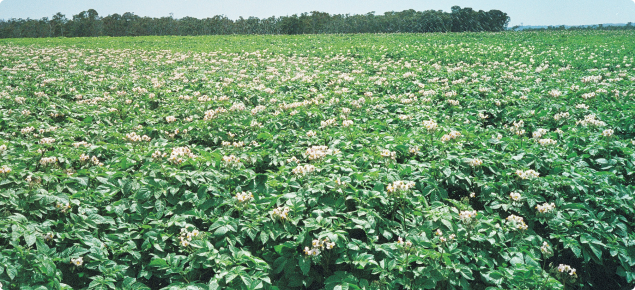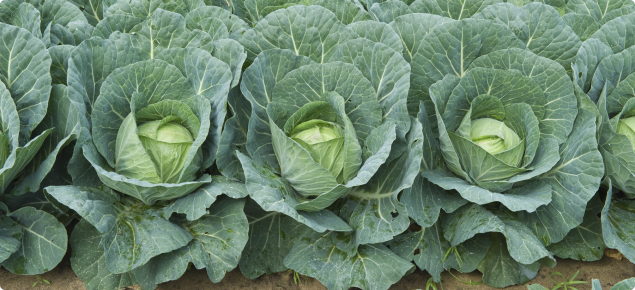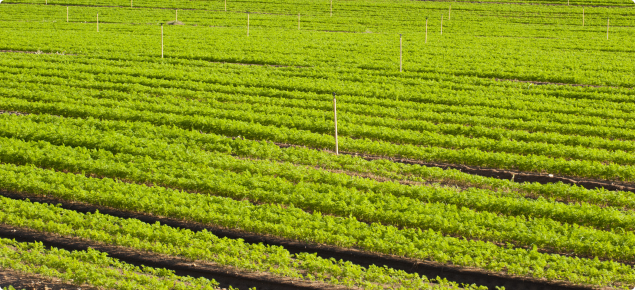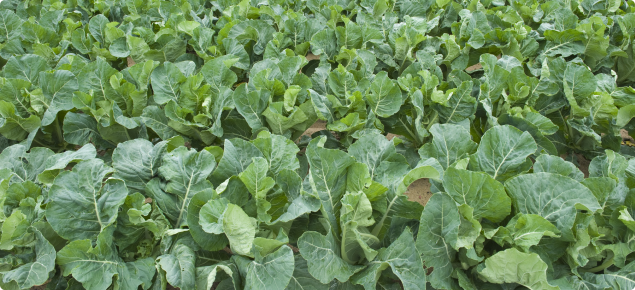The secret to success as a vegetable grower is high yield and high price achieved through high quality. Failure to implement best practice nutrition programs can lead to poor returns.
Costs and returns
Growers strive for 100% of potential yield because the price of vegetables is relatively high compared with most other field crops. However, an extra dollar spent on fertiliser does not always give an extra dollar in return.
The extra fertiliser required to achieve the last 5% in crop yield can double your fertiliser bill. Most of that extra fertiliser is not efficiently used by the crop and can pollute groundwater, lakes and streams.
Good fertiliser management is about balancing costs and returns so that the balance comes out in your favour. The best strategy is often one that produces a little less than maximum yield but gives a high dollar return for the nutrient inputs.
You need to know where this ‘point of diminishing return’ is for your crop and factor it into your planning.
Fertilising your crop
Soil types
Soils of the Swan Coastal Plain are some of the most infertile in the world.
The three main soil types are Spearwood sand, Karrakatta sand and Bassendean sand. Few soils in the world have such low capacity to retain nitrogen.
Fertility and nutrient retention capacity is greatest for Spearwood and least for the Bassendean soil type.
The red/brown Spearwood sands overlay limestone. They were the first choice for vegetable growing but only small areas are now left for vegetable production. They retain phosphorus and potassium to a moderate level and fertility can be improved.
The yellow/brown Karrakatta sands are to the east of the Spearwood sands. They can retain some phosphorus but potassium leaches fairly readily. They have poorer water-holding capacity than Spearwood sands.
Bassendean sands are grey to white on the surface and yellow to pale yellow at depth. They do not retain phosphorus or potassium. Commercial vegetable growing has been forced onto these soils under pressure from urbanisation and they now account for about 40% of production on the Swan Coastal Plain.
Matching fertiliser method to soil
Strategies for growing vegetables on these soils require a steady supply of nitrogen to the crop while minimising waste. Strategies for potassium are similar, with frequent applications during the life of the crop and increased frequency on Bassendean sands.
Phosphorus can be treated differently for the three soils.
On Spearwood sands, phosphorus-containing fertiliser can be broadcast pre-planting at rates determined from soil testing. A similar approach could be followed for Karrakatta sands but in many cases some additional side-dressed phosphorus would be beneficial.
Due to rapid nutrient leaching, soil testing is of very little value on Bassendean sand and regular side dressing at moderate rates is most efficient.
Matching supply and demand
The amount of nutrients needed by a crop changes daily. In a perfect world, we would apply just the right amount of fertiliser to the crop every day. This would meet its needs and it would absorb all fertiliser with no waste. A well-balanced fertiliser program should work towards this objective but it can never be achieved in field cultivation.
In the first few weeks after planting, the total fertiliser requirement of a crop may be less than 1% of its full requirement. At this stage, the crop has only a shallow, confined root system. Placing fertiliser in the root zone, and having it stay at that shallow depth long enough for the crop to get its requirements, presents a challenge.
Later, the crop may be doubling its weight weekly and large amounts of fertiliser will be required to meet these needs. By this time, the crop’s root system is much more extensive and it can recover nutrients for longer time and from greater depth.
Slowing loss of nutrients
Another way to ensure efficient recovery of nutrients — especially nitrogen — is to slow down the rate at which they move through the soil profile. Modifying the soil can be a way of achieving this.
This can be a permanent change — brought about by adding a mineral such as clay — or a semi-permanent change by increasing soil organic matter. Crop residues have this effect over time, but the process can be hastened and better balanced by well-timed use of compost or conditioned manures. Changing the form of nitrogen to less leachable organic forms instead of nitrate can also slow down the rate of loss. A good composting process usually does this.
Plant buffering
Plant leaves and stems are not only powerhouses that produce energy for growth but together with roots are also storage organs. In good conditions, they can accumulate excess nutrients and remobilise them to maintain optimum growth when nutrient availability is low. This ‘natural buffering’ effect should not be underestimated and can help simplify fertiliser management.
Not all fertilisers need to be applied all the time. The natural buffering effect cannot be relied upon to sustain the crop when it is young because it does not have a large storage capability. Later, it can reduce the need to side dress nutrients like potassium and phosphorus.
Nitrogen does not accumulate much in plants and the plant buffering effect cannot be relied upon to sustain the crop for long at any growth stage. It does allow weekly applications to be effective on poor soils.
Effect of irrigation
Your fertiliser program is only as good as your irrigation system and management. Well-designed irrigation systems that give a high degree of uniformity are critical to efficient fertiliser use. Irrigation timing and application rates are critical due to nutrient leaching on sandy soils.
Irrigation on young crops should be for short periods so that only a shallow depth of soil is wetted and nutrients are retained near the surface.
Sprinkler shifts should be small so the area being irrigated at any time does not include too many crops or different planting dates. This is particularly critical when fertigating to ensure the right rate of fertiliser for the growth stage of the crop.
Irrigation should not be the only method of wind and erosion control because this leads to water and nutrient wastage.
Crop and equipment matching
You can improve efficiency of fertiliser use by better matching your machinery and irrigation systems to crop age and type.
One of the most common causes of excess fertiliser use comes from ‘the one size fits all’ principle. It is often easier to leave machinery on the same setting all the time and spread that fertiliser rate over all crop stages.
If equipment cannot easily be reset, set banding and broadcasting equipment at a low application rate and make multiple passes over the crop to account for increasing age and demand.
The same problem occurs when fertigation is used and the sprinkler shift is a large area covering multiple crop maturities or types. After row closure, fertigation is often used when other application methods are no longer possible. The fertiliser rate chosen is usually the one considered right for the most mature crop in the shift. This results in waste on all younger plantings. Smaller shifts, coupled with larger areas of the same maturity, are required for high rate fertigation to be efficient.
Spreading method
The best method to apply fertiliser will vary with the type of crop and its growth stage.
Broadcasting
Broadcasting is best suited for pre-planting applications such as superphosphate and compost. It can also be used on direct-sown or transplanted crops when they are very small and fertiliser granules will not lodge in leaf axils, causing crop damage. Only granular or bulky organic fertilisers are suitable for this method and it can be inefficient because placement is erratic and widespread.
Banding
Banding is well suited to row crops in the weeks leading up to row closure. It can allow high rates of fertiliser to be accurately placed for a crop with a rapidly growing fertiliser demand. It is only suitable when the crop has a large enough root system to use fertiliser placed between rows.
Boom spraying
Boom spraying can be used to apply foliar — leaf absorbed — nutrients or as an alternative broadcasting method for higher rates on young crops. It is far more accurate than a fertiliser spinner, except in windy conditions. There are limits on rates that can be applied without foliage damage if overhead irrigation is not employed at the same time as spraying.
Fertigation
Fertigation can be used throughout the crop life but tends to be used more after row closure. It is a cheap, effective method of distributing nutrients which allows regular application. Its main downfall is that it can be erratic in windy conditions and often leads to overdosing on multiple crop maturities.
It is probably at its best when used to apply a low ‘base load’ rate throughout the crop’s life. This ‘base load’ should be sufficient to establish the crop but would need topping up by other methods later in the life of the crop when these methods are practical. To achieve this, automated sprinkler systems need to be developed.
Choosing products
Cost and performance are important when choosing a product, but it is not always that simple.
The products you choose should supply large quantities of the major nutrients nitrogen, phosphorus and potassium (NPK), moderate quantities of calcium and magnesium and small quantities of trace elements. Products which supply all of these in one bag are usually more expensive because of the cost of mixing or blending.
Some nutrients may also be applied that are already in plentiful supply in the soil.
Single-nutrient products with high concentration are usually cheaper because there are no mixing costs and freight costs per unit of nutrient are lower. However, you may need to mix these yourself to fit into your management system and this is additional cost. Alternatively, you may need to make an extra pass over the crop to apply two fertilisers in single nutrient form. Not all products are stable when mixed and must be applied separately.
Choose a product that best matches the distribution method you plan to use. This may vary at different stages of the crop’s life. If you want to fertigate for example, some products do not fully dissolve in water and are unsuitable for this system.
Decide first how to apply fertiliser for a particular crop stage then choose the cheapest, most user-friendly product which contains the nutrients the crop needs and suits that method.
Monitoring progress and performance
The missing link in efficient fertiliser management is being able to quickly and cheaply prove what you are doing is working and not overdosing the crop. Most crops will take a large measure of overdosing without showing any visible effects. When this is happening, you are wasting fertiliser and money.
The answer may lie in rapid sap tests which can be done cheaply on site to verify the crop is on target. Reliable standards for optimum performance need to be developed for a range of crops in different seasons to make this technology truly useful.
Using drainage lysimeters at regular intervals to measure water and nutrient loads passing below the crop’s root zone can help improve fertiliser management.
Acknowledgement
Dennis Phillips, Bob Paulin and John Burt authored the original version of this material.




